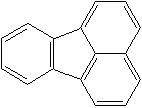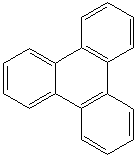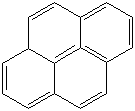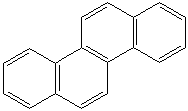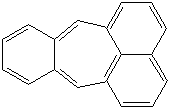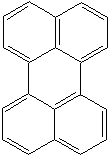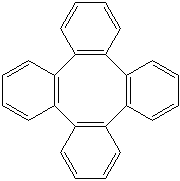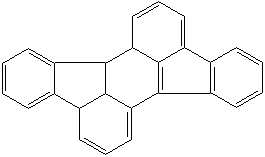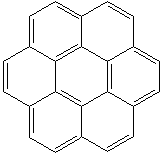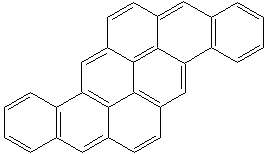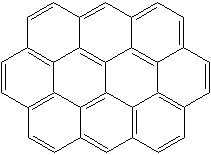GENERAL DESCRIPTION OF PAHs
Polycyclic aromatic hydrocarbons (also called polynuclear hydrocarbons) have two or more single or fused aromatic rings if a pair of carbon atoms is shared between rings in their molecules. In particular, the term 'PAH' refers to the compounds consisting of only carbon and hydrogen atoms while the wider term 'polycyclic aromatic compounds' includes the alkyl-substituted derivatives and functional derivatives such as nitro- and hydroxy-PAH as well as the heterocyclic analogues, which contain one or more hetero atoms in the aromatic structure. PAHs exist in various combinations that manifest various functions such as light sensitivity, heat resistance, conductivity, emittability, corrosion resistance and physiological action. The simplest examples are naphthalene having two benzene rings side by side and biphenyl having two bond-connected benzene rings. PAHs are not found in synthetic products and are non-essential for the growth of living cells. The general characteristics of PAH describe high melting- and boiling-points (they are solid), low vapour pressure, and very low water solubility, decreasing with increasing molecular weight whereas resistances to oxidation, reduction, and vapourization increases. Vapour pressure tends to decrease with increasing molecular weight. PAHs are highly lipophilic and readily soluble in organic solvents. The lower molecular weight PAHs of 2 or 3 ring groups such as naphthalenes, fluorenes, phenanthrenes, and anthracenes have toxicity which tends to decrease with increasing molecular weight. PAHs are not synthesized chemically for industrial purposes but are isolated from concentrated coal-tar products (or from pyrolysis of coal hydrocarbons) followed by subsequent purification through repeated distillation and crystallization. Some PAHs such as naphthalene are also obtained from the concentratation of the high boiling residual oil (and asphalt) derived from crude petroleum refinery processing. These PAHs are mostly used as intermediaries in pharmaceuticals, agriculturals, photographics, thermoset plastics, lubricating materials, and chemical industries. General uses are;
- Acenaphthene: Intermediate for naphthalic acids, naphthalic anhydride (intermediate for pigments) and for acenaphthylene (intermediate for resins); Intermediate for dyes, soaps, pigments, pharmaceuticals, insecticide, fungicide, herbicide and plant growth hormones. It is used to manufacture plastics and as an agent for inducing polyploidy.
- Acridine: Dye and pharmaceutical manufacturing
- Anthracene: Its oxidation yields anthraquinone, the parent substance of a large class of dyes and pigments; .diluent for wood preservatives; scintillant (for detection of high-energy radiation)
- Fluoranthene: manufacturing fluorescent and vat dyes, pharmaceuticals and agrochemicals.
- Fluorene: basic subsance for production of dyes, pigments, pesticides, thermoset plstic and pharmaceuticals; manufacturing fluorenone (mild oxidizing agent)
- Naphthalene: In the production of phthalic anhydride, carbaryl insecticide, beta-naphthol, tanning agents, moth repellent, and surfactants - naphthalene: main use: production of phthalic anhydride (intermediate for polyvinyl chloride plasticizers); also, production of azo dyes, surfactants and dispersants, tanning agents, carbaryl (insecticide), alkylnaphthalene solvents (for carbonless copy paper), and use without processing as a fumigant (moth repellent)
- Phenanthrene: manufacturing phenanthrenequinone (intermediate for pesticides); manufacturing diphenic acid (intermediate for resins)
- Pyrene: manufacturing perinon pigments
- Quinoline: solvent for resins & terpines; decarboxylation agent; parent compound to make drugs, fungicides, biocides, alkaloids, dyes, rubber chemicals and flavoring agents
Precise PAHs, specific refined products are used also in the field of electronics, functional plastics and liquid crystals. Pharmaceutical and agricultural PAHs obtained coal tar are such materials as indole, indolizine, indene, quinoline, quinalidine, isoquinoline and their derivatives. High boiling-point special solvent are such materials as tetoralin, decaline, methyl-naphthalenes. Coumarins and dihydrocoumarins which can be obtained coal tar are PAHs used in perfumery. Thermosensitive paper sensitizer PAHs are such materials as p-benzylbiphenyl and ethylbiphenyl.
|
PARENT COMPOUNDS of PAHs |
|
|
|
|
|
PENTALENE |
INDENE (CAS RN: 95-13-6) |
|
|
|
|
NAPHTHALENE (CAS RN: 91-20-3) |
AZULENE (CAS RN: 275-51-4) |
|
|
|
|
HEPTALENE |
BIPHENYLENE (CAS RN: 259-79-0) |
|
|
|
|
as-INDACENE |
s-INDACENE |
|
|
|
|
ACENAPHTHALENE (CAS RN: 83-32-9) |
FLUORENE (CAS RN: 86-73-7) |
|
|
|
|
PHENALENE (CAS RN: 203-80-5) |
ANTHRACENE (CAS RN:120-12-7) |
|
|
|
|
FLUORANTHENE (CAS RN: 206-44-0) |
ACEPHENANTHRYLENE |
|
|
|
|
TRIPHENYLENE (CAS RN: 217-59-4) |
PYRENE (CAS RN: 129-00-0) |
|
|
|
|
CHRYSENE (CAS RN: 218-01-9) |
NAPHTHACENE (CAS RN: 92-24-0) |
|
|
|
|
PLEIADENE (CAS RN: ) |
PICENE (CAS RN: 213-46-7) |
|
|
|
|
PERYLENE (CAS RN: 198-55-0) |
PENTAPHENE (CAS RN: 222-93-5) |
|
|
|
|
PENTACENE (CAS RN: 135-48-8) |
TETRAPHENYLENE (CAS RN: 212-74-8) |
|
|
|
|
RUBICENE (CAS RN: 197-61-5) |
CORONENE (CAS RN: 191-07-1) |
|
|
|
|
PYRANTHRENE (CAS RN: 191-13-9) |
OVALENE (CAS RN:190-26-1) |












